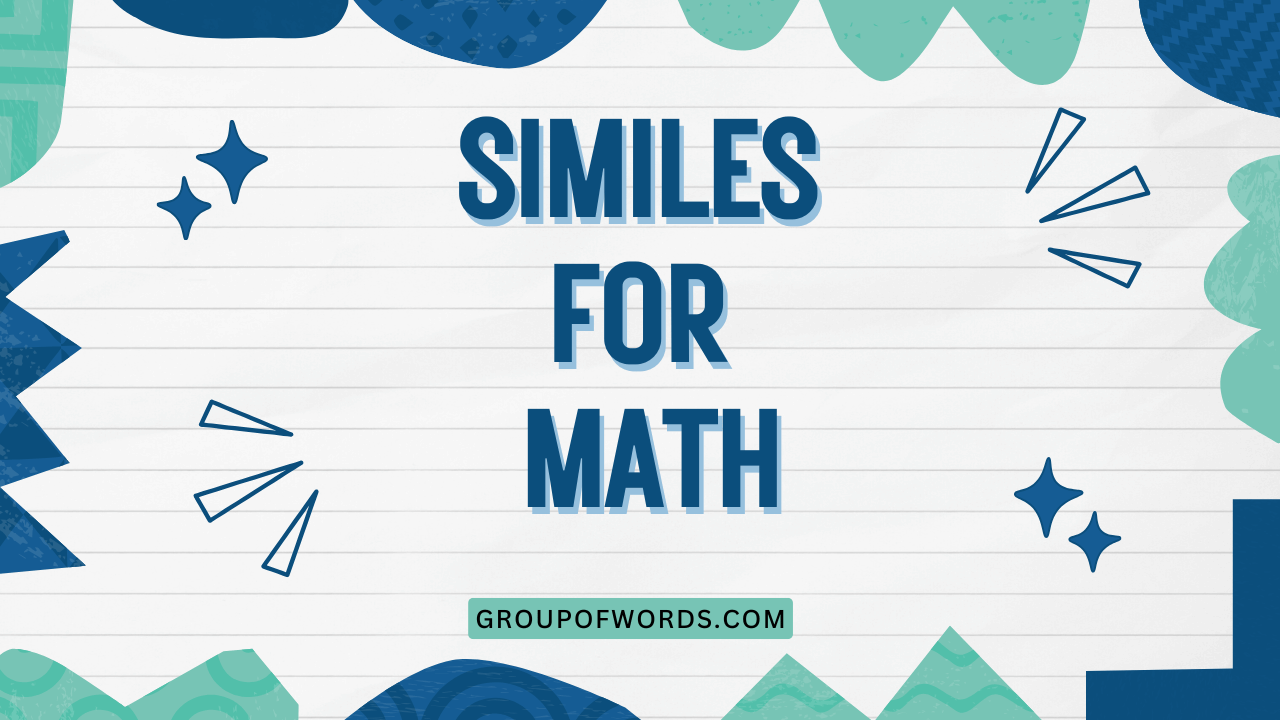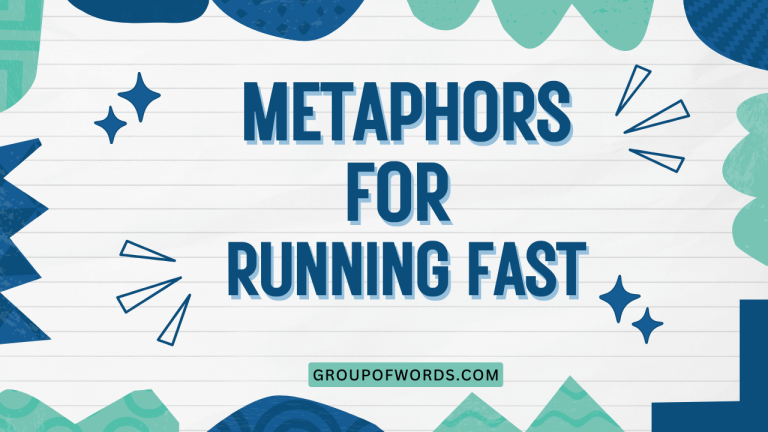Math Similes: Making Numbers Relatable with Figurative Language
Similes are powerful tools in the English language, allowing us to draw comparisons between seemingly unrelated things. While often found in literature and everyday conversation, similes can also be cleverly used to explain and understand mathematical concepts.
By relating abstract numerical ideas to familiar objects or experiences, we can make math more accessible and engaging for learners of all ages. This article explores the world of math similes, providing definitions, examples, and practical exercises to help you master this unique application of figurative language.
This comprehensive guide is designed for students, teachers, and anyone looking to enhance their understanding of both mathematics and the English language. Whether you’re struggling with complex equations or simply seeking a more intuitive way to grasp mathematical principles, this exploration of math similes will offer fresh perspectives and valuable insights.
Table of Contents
- Introduction
- Definition of a Math Simile
- Structural Breakdown of Math Similes
- Types of Math Similes
- Examples of Math Similes
- Usage Rules for Math Similes
- Common Mistakes with Math Similes
- Practice Exercises
- Advanced Topics in Math Similes
- Frequently Asked Questions
- Conclusion
Definition of a Math Simile
A math simile is a figure of speech that compares a mathematical concept to something else, using words like “like” or “as.” Its primary function is to simplify complex ideas by relating them to more familiar and tangible objects or experiences. This helps in visualizing abstract concepts and making them easier to understand.
Math similes can be used to describe shapes, sizes, quantities, probabilities, and even the speed of calculations. They serve as a bridge between the abstract world of numbers and the concrete world we experience every day.
The goal is to create a vivid and memorable connection that aids in comprehension and retention.
For instance, saying “A circle is like a perfectly round coin” makes the concept of a circle more relatable, especially for young learners. Similarly, “Infinity is like a road that never ends” helps to convey the boundless nature of infinity in a more understandable way.
Math similes are valuable tools for educators and students alike, offering a creative and effective approach to learning and teaching mathematics.
Structural Breakdown of Math Similes
Math similes, like all similes, follow a basic structural pattern. Understanding this structure can help you create your own similes to explain mathematical concepts.
The structure typically consists of three key components:
- The Mathematical Concept: This is the subject of the simile, the mathematical idea you are trying to explain. It could be a shape, a number, an operation, or any other mathematical entity.
- The Connecting Word: This is the word that establishes the comparison. The most common connecting words are “like” and “as.”
- The Analogy: This is the object, concept, or experience that the mathematical concept is being compared to. The analogy should be something familiar and easily understood.
The formulaic structure can be represented as follows: Mathematical Concept + Connecting Word + Analogy
For example, in the simile “A square is like a perfectly formed box,” “A square” is the mathematical concept, “is like” is the connecting word, and “a perfectly formed box” is the analogy. This structure provides a clear and concise way to relate the abstract mathematical idea to a concrete, understandable object.
By mastering this structural breakdown, you can effectively craft similes that clarify mathematical ideas and make them more accessible to a wider audience. The key is to choose analogies that are relevant, relatable, and that accurately reflect the properties of the mathematical concept being explained.
Types of Math Similes
Math similes can be categorized based on the type of mathematical concept they are describing. Here are some common categories:
Shape Similes
Shape similes compare geometric shapes to familiar objects. These similes help students visualize and remember the properties of different shapes.
For example, “A triangle is like a slice of pizza” or “A sphere is like a basketball.”
Size Similes
Size similes relate mathematical measurements to real-world scales. These similes can convey the magnitude of numbers or the proportions of objects.
For instance, “A mile is like twenty football fields” or “An inch is like the width of your thumb.”
Speed/Rate Similes
Speed similes compare rates of change or motion to everyday speeds. These similes help to illustrate the concept of velocity and acceleration.
For example, “The speed of light is like an instant teleportation” or “A snail’s pace is like moving one millimeter per hour.”
Quantity Similes
Quantity similes illustrate the size or amount of numbers or sets. These similes are useful for understanding large numbers or fractions.
For example, “A million is like the number of stars you can see on a clear night” or “One-half is like cutting a cake in two equal pieces.”
Probability Similes
Probability similes relate the likelihood of an event to familiar chances. These similes help to understand the concept of probability and risk.
For example, “A 50% chance is like flipping a coin” or “A one-in-a-million chance is like winning the lottery.”
Examples of Math Similes
The following tables provide extensive examples of math similes, organized by category. Each example illustrates how a mathematical concept can be related to a more familiar object or experience.
Table 1: Shape Similes
This table shows examples comparing different geometric shapes to common objects to aid in visualization and understanding.
| Mathematical Concept | Simile | Explanation |
|---|---|---|
| Circle | A circle is like a perfectly round coin. | Illustrates the roundness and consistent curvature of a circle. |
| Square | A square is like a checkerboard space. | Highlights the equal sides and right angles of a square. |
| Triangle | A triangle is like a slice of pizza. | Relates the shape to a common and recognizable object. |
| Rectangle | A rectangle is like a door. | Emphasizes the longer sides and right angles of a rectangle. |
| Cube | A cube is like a dice. | Highlights the three-dimensional nature and equal sides of a cube. |
| Sphere | A sphere is like a basketball. | Relates the shape to a common spherical object. |
| Cylinder | A cylinder is like a can of soup. | Emphasizes the circular ends and curved surface of a cylinder. |
| Cone | A cone is like an ice cream cone. | Relates the shape to a familiar conical object. |
| Oval | An oval is like an egg. | Illustrates the elongated, rounded shape of an oval. |
| Pentagon | A pentagon is like the shape of home plate in baseball. | Relates the shape to a specific, recognizable object. |
| Hexagon | A hexagon is like a honeycomb cell. | Highlights the six-sided nature of a hexagon. |
| Octagon | An octagon is like a stop sign. | Emphasizes the eight-sided shape of an octagon. |
| Parallelogram | A parallelogram is like a leaning rectangle. | Illustrates the slanted sides of a parallelogram. |
| Trapezoid | A trapezoid is like a table with one small side. | Relates the shape to a common object with unequal parallel sides. |
| Rhombus | A rhombus is like a diamond. | Emphasizes the equal sides and slanted angles of a rhombus. |
| Semi-circle | A semi-circle is like half of a pie. | Illustrates half of a circle. |
| Arc | An arc is like a smile. | Relates the curved shape to a familiar expression. |
| Spiral | A spiral is like a winding staircase. | Emphasizes the curving, ascending nature of a spiral. |
| Line | A line is like a string pulled tight. | Illustrates the straightness of a line. |
| Point | A point is like a tiny dot on a map. | Relates the concept to a small, specific location. |
| Right Angle | A right angle is like the corner of a book. | Highlights the 90-degree nature of a right angle. |
| Acute Angle | An acute angle is like a partly opened laptop. | Illustrates an angle less than 90 degrees. |
| Obtuse Angle | An obtuse angle is like a wide open book. | Emphasizes an angle greater than 90 degrees but less than 180. |
| Sector | A sector is like a slice of pizza cut from the center. | Relates the shape to a common object, emphasizing the central cut. |
| Tangent | A tangent is like a car briefly touching a curb. | Illustrates a line that touches a curve at one point. |
Table 2: Size Similes
This table presents examples for comparing mathematical measurements to relatable scales to understand magnitude and proportions.
| Mathematical Concept | Simile | Explanation |
|---|---|---|
| A mile | A mile is like twenty football fields. | Provides a relatable distance for understanding the length of a mile. |
| An inch | An inch is like the width of your thumb. | Relates the measurement to a common body part for easy reference. |
| A foot | A foot is like the length of a standard ruler. | Provides a standard reference for measuring length. |
| A millimeter | A millimeter is like the thickness of a credit card. | Relates the small measurement to a common object. |
| A kilogram | A kilogram is like a large textbook. | Provides a sense of the weight of a kilogram. |
| A gram | A gram is like the weight of a paperclip. | Relates the small weight to a common object. |
| A liter | A liter is like a large bottle of water. | Provides a sense of the volume of a liter. |
| A milliliter | A milliliter is like a single drop of water. | Relates the small volume to a common occurrence. |
| A ton | A ton is like the weight of a small car. | Provides a sense of the immense weight of a ton. |
| A hectare | A hectare is like the size of a soccer field. | Relates the area to a familiar playing field. |
| A centimeter | A centimeter is like the width of your pinky nail. | Relates the measurement to a common body part for easy reference. |
| A microsecond | A microsecond is like the blink of an eye in super slow motion. | Illustrates how incredibly short a microsecond is. |
| A gigabyte | A gigabyte is like a large photo album. | Provides a sense of the storage capacity of a gigabyte. |
| A terabyte | A terabyte is like the entire library of a small town. | Illustrates the huge storage capacity of a terabyte. |
| A nanometer | A nanometer is like one billionth of a meter – unimaginable tiny. | Emphasizes the extremely small scale of a nanometer. |
| A light-year | A light-year is like the distance you’d travel in a lifetime at light speed. | Relates the vast distance to a human perspective. |
| A fathom | A fathom is like the height of a tall adult. | Relates the depth measurement to a relatable height. |
| An acre | An acre is like almost the size of a football field (without the end zones). | Provides a relatable area for understanding the size of an acre. |
| A decibel | A decibel is like the quietness of a library. | Provides a sense of the loudness of a decibel. |
| A lumen | A lumen is like the brightness of a candle. | Relates the light measurement to a common light source. |
| A mole (chemistry) | A mole is like a huge collection of atoms. | Illustrates the vast quantity of atoms in a mole. |
| A pixel | A pixel is like a tiny dot on your computer screen. | Relates the image element to a visible component. |
| A degree (temperature) | A degree Celsius is like a comfortable room temperature. | Provides a relatable temperature for understanding degrees Celsius. |
| Pascal | A pascal is like the pressure exerted by a sheet of paper on a table. | Provides a sense of the pressure of a pascal. |
Table 3: Speed/Rate Similes
This table presents examples comparing rates of change or motion to everyday speeds. It helps illustrate the concept of velocity and acceleration.
| Mathematical Concept | Simile | Explanation |
|---|---|---|
| The speed of light | The speed of light is like an instant teleportation. | Emphasizes the incredibly fast nature of light. |
| A snail’s pace | A snail’s pace is like moving one millimeter per hour. | Relates the slow speed to a common slow-moving animal. |
| Exponential growth | Exponential growth is like a population of rabbits multiplying rapidly. | Illustrates the rapid increase associated with exponential growth. |
| Constant speed | Constant speed is like driving on cruise control on a flat highway. | Relates the concept to a steady, unchanging motion. |
| Acceleration | Acceleration is like a car speeding up on a freeway on-ramp. | Illustrates the increasing speed associated with acceleration. |
| Deceleration | Deceleration is like a car braking to a stop. | Emphasizes the decreasing speed associated with deceleration. |
| Inflation rate | An inflation rate of 5% is like prices increasing slightly each month. | Relates the economic concept to everyday price changes. |
| Decay rate | A decay rate of 10% is like losing a small amount of value each year. | Emphasizes the decreasing value associated with decay. |
| Birth rate | A birth rate of 20 per 1000 is like a small town growing steadily. | Relates the demographic concept to population growth. |
| Interest rate | An interest rate of 4% is like earning a small amount of money on your savings each year. | Emphasizes the earning potential associated with interest. |
| Processing speed | A computer’s processing speed is like how fast you can solve a puzzle. | Relates computational speed to a cognitive task. |
| Data transfer rate | A data transfer rate is like how quickly water flows through a pipe. | Illustrates the speed of data transmission. |
| Sampling rate | A sampling rate is like how often you take pictures to capture a moment. | Relates the concept to capturing data points. |
| Refresh rate | A screen’s refresh rate is like how smoothly a movie plays. | Emphasizes the smoothness of visual updates. |
| Frame rate | A video game’s frame rate is like how responsive the game feels. | Relates the concept to gaming experience. |
| Heart rate | A heart rate of 70 bpm is like a steady drumbeat. | Relates the physiological rate to a rhythmic sound. |
| Breathing rate | A breathing rate is like the rhythm of your chest rising and falling. | Emphasizes the rhythmic nature of breathing. |
| Growth rate | A plant’s growth rate is like how quickly it shoots up towards the sun. | Relates the biological growth to a visible action. |
| Reaction rate | A chemical reaction rate is like how fast ingredients mix together. | Illustrates the speed of chemical processes. |
| Download speed | A download speed is like how quickly you receive a letter in the mail. | Relates the data reception to a familiar delivery process. |
| Walking speed | Walking speed is like a leisurely stroll in the park. | Illustrates a moderate pace of movement. |
| Running speed | Running speed is like a determined sprint to the finish line. | Emphasizes a fast and purposeful movement. |
| Typing speed | Typing speed is like how quickly you can write down your thoughts. | Relates the digital input to a writing process. |
| Cooking speed | Cooking speed is like how quickly you can prepare a delicious meal. | Illustrates the time it takes to prepare food. |
Table 4: Quantity Similes
This table provides examples comparing the size or amount of numbers or sets to relatable quantities, useful for understanding large numbers or fractions.
| Mathematical Concept | Simile | Explanation |
|---|---|---|
| A million | A million is like the number of stars you can see on a clear night. | Provides a sense of the vastness of a million. |
| One-half | One-half is like cutting a cake in two equal pieces. | Relates the fraction to a common division. |
| Infinity | Infinity is like a road that never ends. | Emphasizes the boundless nature of infinity. |
| Zero | Zero is like having nothing in your pockets. | Relates the concept to a state of emptiness. |
| A dozen | A dozen is like a carton of eggs. | Provides a common reference for the quantity of twelve. |
| A gross | A gross is like twelve dozens, or a whole lot of pencils. | Illustrates the quantity of 144. |
| A score | A score is like twenty years. | Relates the quantity to a unit of time. |
| A trillion | A trillion is like the number of leaves on all the trees in a large forest. | Illustrates the immense scale of a trillion. |
| A percentage | A percentage is like a slice of a pie, showing the proportion of the whole. | Relates the concept to a proportional representation. |
| A ratio | A ratio is like a recipe, showing the proportions of different ingredients. | Emphasizes the proportional relationship between different elements. |
| Pi | Pi is like a never-ending decimal, a constant mystery. | Illustrates the non-repeating, non-terminating nature of Pi. |
| A set | A set is like a collection of your favorite things. | Relates the mathematical concept to a personal collection. |
| Prime number | A prime number is like a solitary building that can’t be easily divided into equal parts. | Emphasizes the indivisibility of prime numbers. |
| Complex number | A complex number is like a combination of real and imaginary elements. | Illustrates the dual nature of complex numbers. |
| Fraction | A fraction is like a part of a whole pizza. | Relates the concept to a division of a whole object. |
| Integer | An integer is like a whole step on a number line. | Emphasizes the wholeness of integers. |
| Variable | A variable is like a placeholder in a game – it can change! | Relates the concept to a dynamic element. |
| Constant | A constant is like a fixed rule – it never changes. | Emphasizes the unchanging nature of constants. |
| Equation | An equation is like a balanced scale – both sides must be equal. | Illustrates the balance required in an equation. |
| Algorithm | An algorithm is like a recipe – a step-by-step process. | Relates the concept to a structured process. |
| Function | A function is like a machine – you put something in, and something comes out. | Illustrates the input-output nature of functions. |
| Series | A series is like a chain of numbers, one after another. | Emphasizes the sequential nature of a series. |
| Matrix | A matrix is like a table of data, organized in rows and columns. | Relates the concept to a structured data arrangement. |
| Vector | A vector is like an arrow showing direction and magnitude. | Illustrates the directional nature of vectors. |
Table 5: Probability Similes
This table presents examples comparing the likelihood of an event to familiar chances. It helps to understand the concept of probability and risk.
| Mathematical Concept | Simile | Explanation |
|---|---|---|
| A 50% chance | A 50% chance is like flipping a coin. | Relates the probability to a common and fair chance event. |
| A one-in-a-million chance | A one-in-a-million chance is like winning the lottery. | Emphasizes the extremely low probability of the event. |
| A 100% chance | A 100% chance is like the sun rising tomorrow. | Relates the certainty to a guaranteed event. |
| A 0% chance | A 0% chance is like flying without wings. | Emphasizes the impossibility of the event. |
| High probability | High probability is like drawing a red ball from a bag mostly filled with red balls. | Relates the likelihood to a favorable selection. |
| Low probability | Low probability is like finding a needle in a haystack. | Emphasizes the difficulty of achieving the event. |
| Independent events | Independent events are like flipping two coins – one doesn’t affect the other. | Illustrates the non-influence between independent events. |
| Conditional probability | Conditional probability is like knowing it’s cloudy, increasing the chance of rain. | Relates the probability to a condition that influences the outcome. |
| Expected value | Expected value is like the average outcome if you played a game many times. | Illustrates the long-term average result. |
| Risk assessment | Risk assessment is like checking the weather before planning a picnic. | Relates the concept to evaluating potential dangers. |
| Random event | A random event is like picking a card blindly from a shuffled deck. | Emphasizes the unpredictability of a random event. |
| Statistical significance | Statistical significance is like finding a pattern that’s not just luck. | Illustrates the reliability of a pattern. |
| Sampling bias | Sampling bias is like only asking people who love ice cream about their favorite dessert. | Emphasizes the skewed representation in a sample. |
| Confidence interval | A confidence interval is like giving a range where you’re pretty sure the true answer lies. | Illustrates the range of certainty in an estimate. |
| Margin of error | A margin of error is like saying ‘plus or minus’ when making a guess. | Emphasizes the possible deviation from an estimate. |
| Hypothesis testing | Hypothesis testing is like trying to prove or disprove a theory. | Relates the concept to scientific inquiry. |
| Regression analysis | Regression analysis is like drawing a line through a bunch of scattered points. | Illustrates finding the best fit in data. |
| Correlation | Correlation is like seeing if ice cream sales go up when it’s hot outside. | Emphasizes the relationship between variables. |
| Causation | Causation is like proving that watering plants makes them grow. | Illustrates a direct cause-and-effect relationship. |
| Simulation | Simulation is like creating a virtual world to test a new idea. | Relates the concept to creating a model for experimentation. |
| Monte Carlo method | The Monte Carlo method is like randomly throwing darts to estimate an area. | Emphasizes the use of random sampling to estimate values. |
| Bayesian inference | Bayesian inference is like updating your beliefs as you get more evidence. | Illustrates how new information changes probabilities. |
| Decision tree | A decision tree is like a flowchart guiding you to the best choice. | Relates the concept to a structured decision-making process. |
| Game theory | Game theory is like figuring out the best strategy in a game. | Illustrates strategic decision-making in competitive situations. |
Usage Rules for Math Similes
While math similes are a creative tool, it’s important to use them accurately and effectively. Here are some guidelines to follow:
- Accuracy: Ensure that the analogy accurately reflects the mathematical concept. Avoid misleading or inaccurate comparisons.
- Relevance: Choose analogies that are relevant to the audience and their prior knowledge. A simile that is unfamiliar or confusing will not be effective.
- Clarity: Keep the simile simple and easy to understand. Avoid complex or obscure analogies.
- Context: Use similes in a context where they enhance understanding, not distract from it. They should complement the explanation, not replace it.
- Appropriateness: Consider the age and background of the learners. Some analogies may be more appropriate for certain audiences than others.
By following these guidelines, you can use math similes to effectively communicate mathematical concepts and make them more accessible to a wider audience.
Common Mistakes with Math Similes
Even with a good understanding of math similes, some common mistakes can occur. Being aware of these pitfalls can help you avoid them.
- Inaccurate Analogies: Using an analogy that doesn’t accurately represent the mathematical concept.
- Incorrect: “A square is like a circle.” (Squares and circles have fundamentally different properties.)
- Correct: “A square is like a perfectly formed box.”
- Overly Complex Analogies: Choosing an analogy that is too complex or unfamiliar for the audience.
- Incorrect: “A derivative is like finding the velocity of a particle using Lagrangian mechanics.” (Too complex for introductory calculus students.)
- Correct: “A derivative is like finding the speed of a car at a specific moment.”
- Misleading Analogies: Using an analogy that leads to a misunderstanding of the concept.
- Incorrect: “Infinity is like a very, very large number.” (Infinity is not a number.)
- Correct: “Infinity is like a road that never ends.”
- Using Similes Excessively: Overusing similes can make the explanation confusing or distracting. Use them sparingly and strategically.
By avoiding these common mistakes, you can ensure that your math similes are effective and contribute to a better understanding of mathematical concepts.
Practice Exercises
Test your understanding of math similes with these practice exercises. For each question, create a simile that relates the mathematical concept to a familiar object or experience.
Exercise 1: Identify the Mathematical Concept
For each simile below, identify the mathematical concept being described.
| Question | Answer |
|---|---|
| 1. The diameter of a circle is like the width across a pizza. | Diameter |
| 2. Parallel lines are like train tracks that never meet. | Parallel Lines |
| 3. A kilogram is like a heavy book. | Kilogram |
| 4. A right angle is like the corner of a piece of paper. | Right Angle |
| 5. A prime number is like a lone wolf. | Prime Number |
| 6. A sphere is like a perfectly round ball. | Sphere |
| 7. An algorithm is like a step-by-step recipe. | Algorithm |
| 8. A fraction is like a slice of a pie. | Fraction |
| 9. A variable is like a container that can hold different values. | Variable |
| 10. Zero is like the absence of anything. | Zero |
Exercise 2: Create Your Own Math Similes
Create a simile for each of the following mathematical concepts.
| Question | Possible Answer |
|---|---|
| 1. Area | Area is like the amount of carpet needed to cover a room. |
| 2. Volume | Volume is like the amount of water a container can hold. |
| 3. Perimeter | Perimeter is like the fence around a yard. |
| 4. Radius | Radius is like half the distance across a circular table. |
| 5. Tangent | A tangent is like a straight road briefly touching a roundabout. |
| 6. Mean | The mean is like the average score on a test. |
| 7. Median | The median is like the middle number in a sorted list. |
| 8. Mode | The mode is like the most popular choice in a survey. |
| 9. Range | The range is like the difference between the highest and lowest temperatures in a day. |
| 10. Probability | Probability is like the chance of rain on a given day. |
Advanced Topics in Math Similes
For those looking to delve deeper into the world of math similes, here are some advanced topics to explore:
- Similes in Higher Mathematics: Explore how similes can be used to explain complex concepts in calculus, linear algebra, and abstract algebra.
- Cross-Disciplinary Similes: Investigate how mathematical concepts can be related to ideas in physics, chemistry, and other sciences through similes.
- Cultural and Historical Similes: Examine how different cultures and historical periods have used analogies to understand and explain mathematical ideas.
- Cognitive Science of Similes: Study the cognitive processes involved in understanding and creating similes, and how they contribute to learning and comprehension.
- Similes in Mathematical Proofs: Explore how similes can be used as a heuristic tool to develop and understand mathematical proofs.
By exploring these advanced topics, you can gain a deeper appreciation for the power and versatility of math similes as a tool for understanding and communicating mathematical ideas.
Frequently Asked Questions
What is the main purpose of using similes in math?
The main purpose is to simplify complex mathematical concepts by relating them to familiar objects or experiences, making them easier to understand and remember.
How do I choose the right analogy for a math simile?
Choose an analogy that is accurate, relevant to the audience, clear, and appropriate for the context and age group.
Can similes be used for all mathematical concepts?
While similes can be helpful for many concepts, they may not be suitable for every mathematical idea, especially those that are highly abstract or technical.
Are there any risks in using math similes?
Yes, inaccurate or misleading analogies can lead to misunderstandings. It’s important to ensure that the simile accurately reflects the mathematical concept.
How can I improve my ability to create effective math similes?
Practice creating similes for different mathematical concepts, and get feedback from others to ensure that your analogies are clear, accurate, and relevant.
Can similes be used in mathematical proofs?
While similes are not typically used in formal mathematical proofs, they can be a valuable tool for developing intuition and understanding the underlying concepts of a proof.
Are similes only for beginners in math?
No, similes can be useful for learners of all levels, including advanced students and professionals, to gain new perspectives and insights into complex mathematical ideas.
What if I can’t think of a good simile for a particular concept?
Don’t force it. Some concepts may be better explained through other methods.
Focus on finding analogies that are truly helpful and avoid using similes just for the sake of it.
Conclusion
Math similes are a valuable tool for making abstract mathematical concepts more accessible and understandable. By relating numbers, shapes, and operations to familiar objects and experiences, we can create vivid and memorable connections that aid in comprehension and retention.
Whether you’re a student, a teacher, or simply someone looking to enhance your understanding of mathematics, mastering the art of math similes can open up new avenues for learning and appreciation.
From visualizing shapes as everyday objects to understanding probabilities as familiar chances, similes offer a creative and effective approach to bridging the gap between abstract mathematical ideas and the concrete world we experience every day. By following the usage rules, avoiding common mistakes, and practicing regularly, you can harness the power of math similes to unlock a deeper understanding of the world of numbers and equations.






